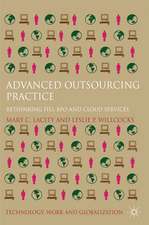Second-Wave Enterprise Resource Planning Systems: Implementing for Effectiveness
Editat de Graeme Shanks, Peter B. Seddon, Leslie P. Willcocksen Limba Engleză Hardback – 10 sep 2003
Preț: 724.87 lei
Preț vechi: 842.87 lei
-14% Nou
Puncte Express: 1087
Preț estimativ în valută:
138.72€ • 144.29$ • 114.52£
138.72€ • 144.29$ • 114.52£
Carte tipărită la comandă
Livrare economică 14-28 aprilie
Preluare comenzi: 021 569.72.76
Specificații
ISBN-13: 9780521819022
ISBN-10: 0521819024
Pagini: 468
Ilustrații: 50 b/w illus.
Dimensiuni: 186 x 255 x 28 mm
Greutate: 1.12 kg
Editura: Cambridge University Press
Colecția Cambridge University Press
Locul publicării:Cambridge, United Kingdom
ISBN-10: 0521819024
Pagini: 468
Ilustrații: 50 b/w illus.
Dimensiuni: 186 x 255 x 28 mm
Greutate: 1.12 kg
Editura: Cambridge University Press
Colecția Cambridge University Press
Locul publicării:Cambridge, United Kingdom
Cuprins
Introduction; Part I. Implementation and Effectiveness: Overview; 1. Learning from adopters' experiences with ERP M. Lynne Markus, Sheryl Axline, David Petrie and Cornelis Tanis; 2. Innovating with Packaged Business Software: toward an assessment E. Burton Swanson; 3. A comprehensive framework for assessing and managing the benefits of enterprise systems Shari Shang and Peter B. Seddon; 4. The continuing ERP revolution: sustainable lessons, new modes of delivery Jeanne W. Ross, Michael R. Vitale and Leslie P. Willcocks; Part II. From Risks To Critical Success Factors: 5. Enterprise system implementation risks and controls Severin V. Grabski, Stewart A. Leech and Bai Lu; 6. Risk factors in Enterprise-Wide/ERP projects Mary Sumner; 7. A framework for understanding success and failure in Enterprise Resource Planning system implementation Christopher P. Holland and Ben Light; 8. Critical success factors revisited: a model for ERP project implementation Anne Parr and Graeme Shanks; 9. Offsetting ERP risk through maintaining standardized application software Guy G. Gable, Taizan Chan, and Wui-Gee Tan; Part III. From Learning to Knowledge: 10. Implementing Enterprise Resource Planning systems: the role of learning from failure Judy E. Scott and Iris Vessey; 11. ERP projects: good or bad for SMEs? Frédéric Adam and Peter O'Doherty; 12. The role of the CIO and IT Function in ERP Leslie P. Willcocks and Richard Sykes; 13. Enterprise systems management with reference process models Michael Rosemann; 14. An ERP implementation case study from a knowledge transfer perspective Zoonky Lee and Jinyoul Lee; 15. Knowledge Integration Processes within the context of Enterprise Resource Planning systems implementation Jimmy Huang, Sue Newell and Robert Galliers; Part IV. Cultural Aspects of Enterprise Systems: 16. An exploratory analysis of the sources and nature of misfits in ERP implementations Sia Siew Kien and Christina Soh; 17. Implementing Enterprise Resource Packages? Consider different organisational and national cultures! Marina Krumbholz, Julia Galliers and Neil A. M. Maiden; Part V. Future Directions: 18. Continuity versus discontinuity: weighing the future for ERP packages M. Lynne Markus, David Petrie and Sheryl Axline.
Descriere
How to get the most out of Enterprise Resource Planning (ERP) systems.











